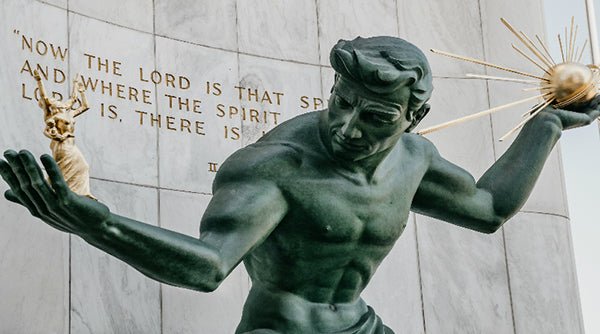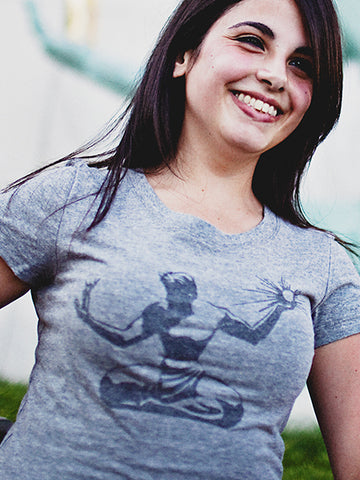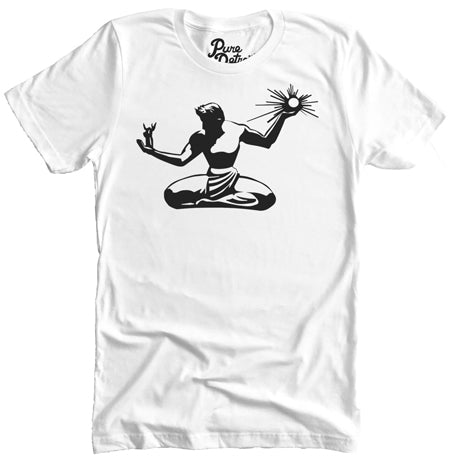
The Spirit of Detroit - The Endurance of Marshall Fredericks
By Jacob Jones
Throughout Detroit’s history, many architects, designers, and artisans have been able to capture important pieces of Detroit’s culture in their work. Albert Kahn’s buildings highlighted the city’s industrial might. Wirt Rowland’s skyscrapers captured what was possible during the economic boom of the Roaring Twenties, Mary Chase Stratton’s Pewabic Pottery showcased the craftsmanship that could exist inside of a Detroit home. But few artists better captured the soul and spirit of Detroit better than the sculptor Marshall Fredericks. In a career that spanned over seven decades, Fredericks would create public art that would leave on lookers inspired. The work would have them pondering over the connection between the spiritual and natural world and force them wonder about there place in it.
Fredericks credited hist keen sense of humanity to his Scandinavian heritage. But his Midwestern roots may have had just as large of an impact on his future. The artist who would become known for combining nature with humanity was born in Illinois. He would be raised in Cleveland and would eventually follow a job at Cranbrook to Detroit.

Fredericks first major work, the Levi Barbour Memorial Fountain, was a great sign of what was to come from the young sculptor. The fountain’s namesake, Barbour was a civic minded Detroit real estate tycoon around the turn into the 20th century.
Upon his death, he bequeathed $20,000 to the city to build a fountain in his honor on Belle Isle. Barbour had used his influence to bring the island under city control in 1879 and he hoped that after his death, the fountain would serve as a “continual hint to fellow citizens to devote themselves to the benefit and pleasure of the public.”

Fredericks won competition to gain the commission for the fountain. He created what would be the first in a long line of civic backed projects that would benefit the public. The fountain features a muscular gazelle cast climbing atop a marble pedestal. His design presents the animal in a victorious pose. As the gazelle moves upwards, water shoots into the sky from the base of the fountain. At it’s dedication on June 25, 1937, Fredericks expressed that his design was “meant to express beauty in nature and its creation.” Fredericks was using this public park, a place created to be a spot of refuge in an ever growing industrial city, to celebrate the creation of nature and the preservation of it. Although the gazelle is not native to Michigan, let alone the city of Detroit, its place on the island was a natural fit.
The Barbour Fountain raised Fredericks’ profile and his increased fame led to commissions on large scale civic projects.

From this point forward, many of his works would be featured in areas that would attract massive crowds. In the early 1950s, Detroit was coasting off of the economic boom that spawned out of the city’s run as the Arsenal of Democracy. The city’s leaders began to redevelop its downtown, specifically focusing on changing its riverfront from an industrial site into a public site. On land located just off the river that was designated for civic use, the Veterans Memorial Building was built. The 10-story structure, built in the International Style, features one of Fredericks most famous works, a 30-foot tall Victory Eagle.
The eagle is carved in relief onto the marble face of the building and although the building is a war memorial, the eagle is not a simple Americanized bald-eagle that so many are used to seeing. Fredericks’ version is more stylized, the bird’s skinny wings rise far above its head and it appears as if it will soar right off the building and into Detroit’s rapidly expanding downtown.

To the west of the Veterans Memorial Building stands seven pylons which were also designed by Fredericks. Fredericks prided himself on the accessibility of his works. Most of his sculptures can be approached by any person who finds themselves walking past them. The Victory Eagle was raised above the street level making it slightly inaccessible by Fredericks’ standards. The pylons countered this, as you walk towards Huntington Place, the pylons tower into the sky one after the other. Each featured engravings rich in detail. The first shows a preaching Father Gabrielle Richard, on the second Chief Pontiac is signing a treaty. The War of 1812, Lee and Grant at Appomattox, and a scene from the Spanish-American war are immortalized on the next three.

The Veterans Memorial was a piece of a larger civic center plan for the downtown land on both sides of Jefferson. The culmination of this plan was the joint City-County Building which opened in 1954. The Detroit-Wayne Building Authority commissioned Fredericks to build a statue for the building’s Woodward facing side in 1955. Fredericks created a to-scale model of the statue and sent it to Norway to be cast and colored. The finished statue was placed onto a specialized ship and sent back to Detroit to be unveiled in 1958.

The statue was lifted off the ship by crane and moved to the City-County Building. The 12 tons of sculpture was lowered into its seated position on the block between Larned and Jefferson at the foot of Woodward Avenue and stripped of its burlap covering. Detroiters gathered to watch in amazement at what the city would call “a statue but more, an idea, a dream, a hope, caught in imperishable bronze.”
On September 23, 1958, three days after the initial unveiling of the 25-foot tall statue, a group of Detroiters that included politicians and pedestrians alike crowded around the massive green figure for its dedication. Fredericks intended to “express the spirit of man through the deity and the family,” like most of his works, Fredericks had combined the natural and spiritual world into one piece, in one hand the figure holds a family in one hand symbolizing humanity. The bronze sphere in the other represents God. The statue presented an idea of unity. This was pushed further by the groups of people who attended the event. City leaders gave speeches, the parks department provided a choir, and faith leaders of different denominations gave the statue their blessings.
The statue was not titled the Spirit of Detroit originally but the name grew out of the importance that it began to play as a symbol for Detroiters. Fredericks had achieved what he always set out to do, create an accessible piece of art that allowed the public to ponder its meaning and apply it to their own lives.

In 1965, seven years after the unveiling of the statue, the Detroit city government released a highlight video of sorts. The economic boom of the 1950s had turned Detroit into one of America’s most important cities. “Detroit: A City on the Move” highlighted Detroit’s transition from an industrial power into what the video’s narrator, Mayor Jerome Cavanagh, called the most cosmopolitan city of the Midwest.
The video spotlights the city’s more modern structures. The international style skyscrapers and modern amenities overshadow the art deco skyscrapers which are mainly only seen in the background. The city was clearly trying to distance itself from the previous generation.
But scattered between the shots of the city’s modern convention centers and apartment buildings were shots of its public art. When Mayor Cavanagh said emphatically that Detroit was “daring to reach up” the camera did not move to the modern buildings, it did not move to its roaring 20’s gems either, instead it panned from the Victory Eagle to the Spirit of Detroit. Two works that stand the test of time. They do not belong to the city’s past, its present or to the future but instead to the spirit that exists throughout time.
Thanks for reading! Please take a moment to check out a sampling of our Pure Detroit - Spirit of Detroit apparel and mugs below:





